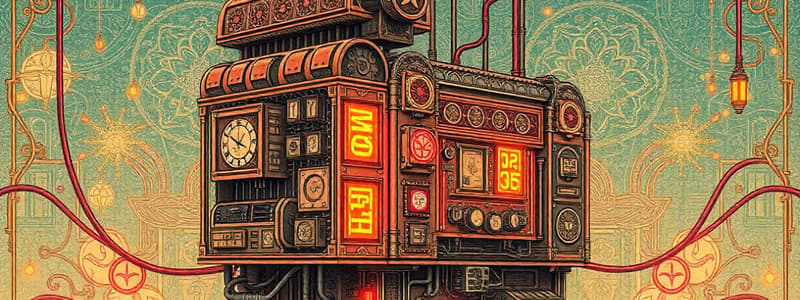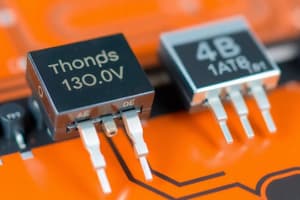Podcast
Questions and Answers
Which type of flip flop captures the value of the data input on a clock edge?
Which type of flip flop captures the value of the data input on a clock edge?
- D Flip Flop (correct)
- JK Flip Flop
- T Flip Flop
- SR Flip Flop
What distinguishes latches from flip flops in terms of sensitivity?
What distinguishes latches from flip flops in terms of sensitivity?
- Latches operate based on time intervals, while flip flops rely on input changes.
- Latches are clock-sensitive, while flip flops are level-sensitive.
- Latches are edge-sensitive, while flip flops are triggered by enable signals.
- Latches are level-sensitive, while flip flops are edge-sensitive. (correct)
In which scenario would a T Flip Flop be most effectively used?
In which scenario would a T Flip Flop be most effectively used?
- To toggle states on each clock pulse when the T input is high. (correct)
- To maintain a state as long as the enable signal is active.
- For temporary data storage without a clock input.
- To set or reset the output based solely on active low inputs.
What is a primary application of flip flops in digital circuits?
What is a primary application of flip flops in digital circuits?
Which type of latch operates without a clock and changes output while inputs are active?
Which type of latch operates without a clock and changes output while inputs are active?
Flashcards are hidden until you start studying
Study Notes
Flip Flops
-
Definition: Flip flops are bistable circuits that can hold one of two states.
-
Types:
- SR Flip Flop: Set-Reset, basic flip flop with two inputs (Set and Reset).
- JK Flip Flop: Extension of SR, can toggle states based on inputs.
- D Flip Flop: Data flip flop, captures the value of the data input (D) on a clock edge.
- T Flip Flop: Toggle flip flop, changes states on each clock pulse when T input is high.
-
Functionality:
- Each flip flop has a clock input which triggers state changes.
- Output depends on the current state and the inputs.
-
Applications:
- Data storage (registers)
- Frequency dividers in digital circuits
- State machines in sequential logic.
Latches
-
Definition: Latches are level-sensitive devices that can store one bit of data.
-
Types:
- SR Latch: Similar to SR flip flop but operates without a clock; it changes state while inputs are active.
- D Latch: Captures the input value when the enable signal is active.
-
Functionality:
- Latches are transparent when enabled, meaning output follows the inputs.
- They maintain their state when the enable is deactivated.
-
Applications:
- Temporary data storage
- Level-sensitive memory elements
- Building blocks for more complex memory storage systems.
Key Differences
-
Sensitivity:
- Latches are level-sensitive (active when enabled).
- Flip flops are edge-sensitive (active on clock edges).
-
Operation:
- Latches can change state as long as the enable signal is active.
- Flip flops change state only at specific moments (clock edges).
-
Usage:
- Latches are often used in simpler applications where level sensitivity is acceptable.
- Flip flops are preferred in synchronous circuits requiring precise timing control.
Flip Flops
- Bistable circuits capable of storing one of two states (0 or 1).
- Triggered by a clock input, which determines when state changes occur.
Types of Flip Flops
- SR Flip Flop:
- Set (S) and Reset (R) inputs.
- Sets the output to 1 when S is high, resets to 0 when R is high.
- JK Flip Flop:
- Extension of SR flip flop.
- Additional J and K inputs that allow for toggling between states (changing from 0 to 1 or vice-versa).
- D Flip Flop:
- Single data input (D) and a clock signal.
- Captures the value of the data input (D) on the rising or falling edge of the clock signal.
- T Flip Flop:
- Single input T and a clock signal.
- Toggles between states (0 to 1 or 1 to 0) on each positive clock edge when T is high.
Applications of Flip Flops
- Data storage (registers)
- Frequency dividers in digital circuits
- State machines in sequential logic
Latches
- Level-sensitive devices that store one bit of data.
- Remain in the same state as long as the enable signal is active.
Types of Latches
- SR Latch: Similar to SR flip flop but lacks a clock signal; state changes while inputs are active.
- D Latch: Captures the input value (D) when the enable signal is high.
Functionality of Latches
- Transparent operation when enabled - output follows the input.
- Output is held constant when the enable signal is low (deactivated).
Applications of Latches
- Temporary data storage
- Level-sensitive elements in memory systems.
- Building blocks for more complex memory storage systems.
Key Differences Between Latches and Flip Flops
- Sensitivity: Latches are level-sensitive, while flip flops are edge-sensitive.
- Latches respond to the input value as long as the enable signal is active.
- Flip flops respond to input only on a specific clock edge (rising or falling).
- Operation:
- Latches change state while the enable signal is active.
- Flip flops change state only at the clock edge.
- Usage:
- Latches are more suitable for simpler applications where level sensitivity is acceptable.
- Flip flops are preferred in synchronous circuits that demand precise timing control.
Studying That Suits You
Use AI to generate personalized quizzes and flashcards to suit your learning preferences.




